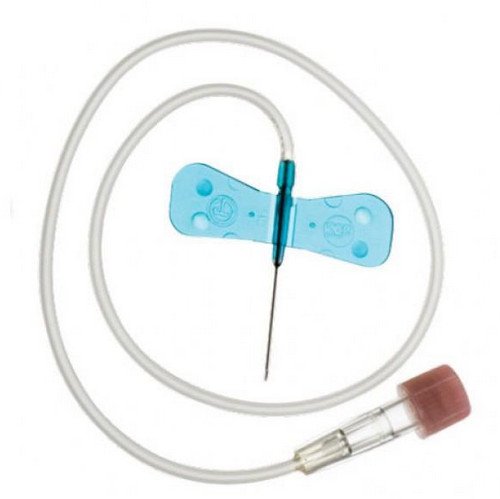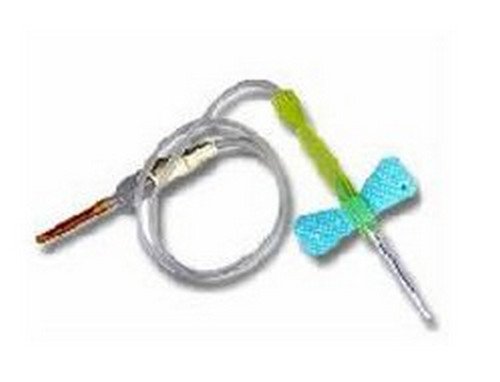Butterfly Needle
Last reviewed by Dr. Raj MD on January 12th, 2022.
What is a butterfly needle?
It is a short needle with a tiny diameter attached to a flexible, thin tube. It comes with two rubber wings enabling the needle to move with ease. A butterfly needle is also called winged infusion set or scalp vein set.
It is specially designed for venipuncture. Through this tool, superficial veins can be easily accessed. Butterfly needle gauge varies. Ideally, the higher the number, the thinner the needle. Butterfly needle size ranges from 18 to 27 gauge bore. (1, 2)

Image 1: A butterfly needle set with two rubber wings for easy grip.
Photo Source: cdn.shopify.com

Picture 2: A butterfly needle set with a push button retract needle.
Image Source: www.pulmolab.com

Photo 3: A blue tourniquet wrapped around the patient’s arm and a butterfly needle inserted into the veins.
Picture source: www.bd.com

Image 4: A blood collection set with a butterfly needle.
Photo Source: imgcdn.mckesson.com
Types of butterfly needles
- Standard safety device – It comes with two common sizes: 21 gauge and 23 gauge. It consists of needle, tube, and the needle is attached to the hub.
- Push button safety device – It is available in various sizes and consists of a needle, tube, and a luer lock.
The newer types of butterfly needles come with a slide and lock safety device, which are effective in preventing needle stick injury. (2, 3)
What is the functions of the butterfly needle?
A butterfly needle is used to draw blood samples from the body (wrist, hand, and foot). It is the right needle to use in patients with shallow veins or those who move a lot or anxious when a blood is drawn. A butterfly needed is also useful for blood transfusion.
Inserting a needle is an invasive procedure but it is a reality of life. At some point in life, nearly all of us will have a needle encounter for medical reasons. (3, 4, 5)
To whom does butterfly needle use for?
- It is used when performing phlebotomy on infant, children, and geriatric patients.
- It is used in patients with difficult draws.
- It is used to collect large quantity of blood such as in blood culture.
- A butterfly needle is used to collect blood, chemo infusion, pain medication, IV infusion, and antibiotic treatment. (5, 6)
What are the advantages of using a butterfly needle?
- Using a butterfly needle creates less pain as compared to using the standard needle.
- A butterfly needle set makes it unlikely for the patient’s vein to collapse. This is because of the butterfly needle’s smaller gauge and length attached to the tubing.
- The butterfly needle set is perfect in patients with small veins such as in children and seniors.
- It makes obtaining blood samples in delicate patients easy. The heel stick method is no longer needed.
- The harmful risk of inserting a needle to the vein is significantly reduced.
- Nerve damage is extremely low when using a butterfly needle.
- The phlebotomist can easily get a flash to let them know that they are hitting the right vein.
- If properly secured, the butterfly needle can be left in place for a few hours or up to a week.
- A butterfly needle can be precisely placed and can be used in superficial, smaller veins.
- It provides a more stable method of infusion. (4, 6, 7, 8)
Are there any disadvantages of using a butterfly needle?
- There is a possibility of hemolysis (rupture of red blood cells) because the needle is extremely small. There could be damage to the blood cells and clumping of platelets.
- A butterfly needle makes it difficult to collect a huge quantity of blood.
- When using a butterfly infusion set, filling a syringe or evacuated tubes may take some time.
- The butterfly needle with tube system should be in the arm for a longer period of time because the blood flow is extremely slow. The tourniquet should stay longer in the arm, which most likely lead to abnormal result for some types of blood test.
- During the blood drawing procedure, the phlebotomist might experience rolling and collapsing of veins.
- A butterfly needle set is more expensive than the usual needle set. (8, 9, 10)
Considerations when using a butterfly needle
- It is a must to use gloves during the IV insertion to prevent contamination.
- Before inserting the needle, make sure you disinfect the puncture site using alcohol or iodine solution.
- The vein should be felt before the insertion of needle to find out the size and firmness of the veins. It also helps you assess if the patient is qualified for needle insertion.
- A butterfly needle should be inserted at a 30-degree angle directed to the flow of blood.
- Make the procedure more comfortable to the patient by being polite and nice during the entire procedure. (1, 4, 6, 7)
How to use the butterfly needle set?
- Make sure your hands are clean during the procedure.
- Remove the butterfly needle set from the packaging and attach the tube valve into the tube holder.
- Use a clean tourniquet and place around the arm of the patient. Gently and thoroughly examine and locate the vein. If you can’t easily locate the vein, try warming the patient’s elbow crease.
- Once you already located the insertion site, the next step is to disinfect the site.
- Make sure that it is completely dry before inserting the needle.
- Remove the needle’s safety cap, hold it by its wings for a controlled grip.
- Gently and carefully insert the needle into the vein, making sure that it is parallel to the direction of the vein at about 30 degrees angle.
- If you are in the correct site, you will notice the flow of blood in the tube. If there is no blood, remove the needle. Reposition and reinsert the needle in another vein.
- If the vacuum tube is filled with blood, it is now time for you to remove the tourniquet. Remove the needle and cover the insertion site with a cotton. Apply pressure to stop the bleeding.
- Make sure you dispose the needle set properly. There is a designated container for sharp objects like needles. (2, 4, 7, 8, 9, 10)
How to draw blood with butterfly needle (how to insert) ?
References:
- http://butterfly-needle.blogspot.com/2013/06/brief-instructions-on-how-to-use.html
- https://en.wikipedia.org/wiki/Winged_infusion_set
- https://medical-diagonosis.wonderhowto.com/how-to/draw-blood-with-butterfly-needle-424755/
- https://healthfully.com/butterfly-needle-5993888.html
- https://www.verywell.com/butterfly-needles-for-blood-draws-and-simple-ivs-430065
- http://butterfly-needle.blogspot.com/2014/04/butterfly-needle-advantages-and.html
- http://www.plcofamerica.com/blog/2013/04/11/winged-infusion-needles-butterfly-needles/
- http://www.ephlebotomytraining.com/butterfly-needles-explained/
- http://www.vacuaptaca.it/en/needles-and-accessories.html
- https://www.firstaid4less.co.uk/Medical-Disposables/Infusion-Needles-Blood-taking/Winged-Butterfly-Infusion-Set